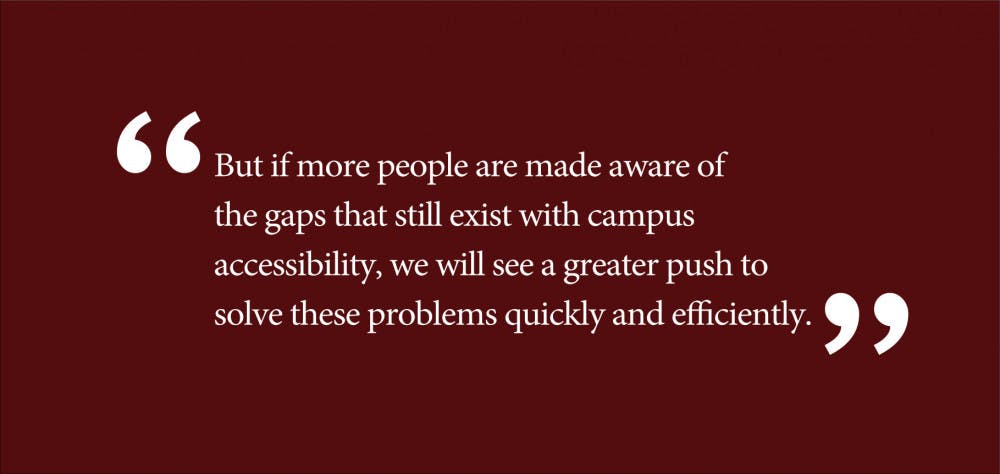There is a lot of rhetoric about increased awareness of social injustices on Brown’s campus. And yet, we are not taking enough initiative to increase accessibility for students with physical disabilities. The Americans with Disabilities Act requires that any and all measures be taken to ensure that students with disabilities receive equal access to educational services — including the removal of architectural barriers and provision of auxiliary services. Brown has not lived up to this mandate, even thirty years after the passage of the ADA.
Of course, I am not insinuating that this is a new problem. The general lack of accessibility support and services on college campuses has been a persistent issue, and as an able-bodied student at this university, I am not the authority in what this experience is like. But given that Brown values progress and that one in ten college students lives with a physical disability, change needs to happen more swiftly.
Brown has made concerted efforts in recent years to push back against ableism by increasing accessibility to those with physical disabilities. For example, Brown offers accessible restrooms and parking throughout campus and provides wheelchair rentals to those who need them. But Brown can and should be doing more. Students who possess a disability do not have equal opportunities when compared to their able-bodied peers. As a student body, we often discuss how challenging it is to complete all that we need to get done in a given day, but imagine having to factor in the added challenge of a physical disability.
We should be making it as easy as possible for those with physical disabilities, and there are some clear areas for improvement.
First, supposedly accessible parking is not as accessible as it could be. My roommate, who sustained an injury this summer that limits her ability to walk for the semester, cannot find handicapped parking closer than Smitty-B — a lot five minutes away from her classes. The scarcity of accessible parking spots diminishes the actual utility of offering such parking in the first place.
And students with disabilities may not have access to a car to help them get around campus. In that case, they must use a wheelchair or scooter to get from class to home — given how cracked and uneven many parts of the sidewalks are around campus, this proves a particularly arduous task to undertake multiple times a day.
To that end, Student and Employment Accessibility Services, and the University at a broader level, could do more to make shuttle pickups a seamless process. Currently, SEAS will not pick up or drop off students at off-campus locations, despite how close these locations may be to parts of campus. Seventy to eighty percent of seniors at Brown live off campus, but those who rely on SEAS shuttles for transport may be left unable to participate in this practically class-wide social activity.
It is unfair to indirectly encourage students with disabilities to live on campus as a result of this policy; this exacerbates a divide between individuals with disabilities and those without them. Shouldn’t all students get to make the exciting decision to live with a group of their friends without disability serving as a deciding factor? There may be an alternative to this SEAS shuttle problem, but if such an alternative exists, it is not adequately advertised.
In a similar vein of advertising options and accommodations, Brown could better display exactly where accessible entrances and exits are located across academic buildings. While most of the buildings on campus have wheelchair entrances and ramps, they are not clearly marked. Sayles Hall, for example, has a particularly confusing accessible entrance for those who do not know where to look. Compounding this problem, many of the “accessible” entrances that are in place do not even function. The automatic doors at Smitty-B and the Pizzitola, for example, do not open when the entrance button is pushed.
Ideally, every building on campus would be accessible. While this proves a logistical challenge on a campus with centuries-old buildings and designated historical landmarks (many buildings were built with a dated framework that does not allow for the incorporation of elevators), at the very least, proper signage and equipment should be put in place to help students locate the accessible entrances.
I do not mean to ignore all that Brown has done in recent years to improve the physical accessibility of campus. Compared to other universities in the United States, Brown has made significant strides. But if more people are made aware of the gaps that still exist with campus accessibility, we will see a greater push to solve these problems quickly and efficiently . To have a physical disability on this campus remains a huge burden, one that I cannot presume to fully understand.
There are tangible ways we can fix many of these problems right now, be that repaving uneven surfaces, adding more handicapped parking or ensuring the functionality of accessible entrances and automatic doors. But to bring about even simple changes, we must first acknowledge them as a student body.
Anna B. Kramer ’20 can be reached at anna_kramer@brown.edu. Please send responses to this opinion to letters@browndailyherald.com and op-eds to opinions@browndailyherald.com.





